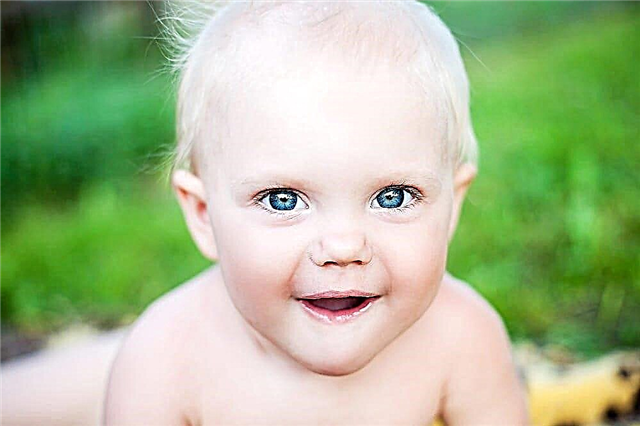Strabismus (strabismus, heterotropy) is a special type of pathology of the oculomotor apparatus, which manifests itself, in addition to a cosmetic defect, as a serious impairment of visual functions. A timely detected strabismus of children can be eliminated, which restores the quality of life and eliminates the visible defect.
There are the following types of strabismus in children: strabismus in newborns, imaginary, latent and true strabismus.
Strabismus in newborns
It occurs due to low visual acuity and the lack of the baby's ability to fix an object with two eyes (binocular vision).
 Remember that in a newborn, the eye begins to function only after birth. The small size of the structures, the physiological features of the formation and analysis of images cause strabismus in infants.
Remember that in a newborn, the eye begins to function only after birth. The small size of the structures, the physiological features of the formation and analysis of images cause strabismus in infants.
By 2 - 3 months, the baby is able to recognize close people who spend a sufficient amount of time with him. Probably, the recognition process in this case is due to the first attempt to combine information from all the senses, since visual acuity is still low.
By 4 - 5 months, when the child begins to actively and for a long time follow the subject of interest to him, strabismus in infants gradually decreases and disappears.
In contrast to newborns, children older than 6 months begin to experience the first attempts to fix an object with two eyes, and, consequently, the ability to three-dimensional vision. The brain merges the received images from the eyes into one picture, which makes it possible to speak of binocular vision. It is believed that when newborn squint completely resolves, the eye begins to function fully.
If after 6 months strabismus does not go away, but, on the contrary, begins to grow, then you should contact an ophthalmologist.
To correct strabismus in children 4 - 5 months old, it is recommended to use mobiles, bright large toys, following the movements of which the child begins to try to fix himself on the object as long as possible.
Imaginary squint
Feigned squint is a variant of the norm. It is associated with asymmetrically located eye sockets, features of the facial skull, the presence of a one-sided skin fold in the corner of the eyes (epicanthus), as well as individual characteristics of the relationship between the optical and visual axis of the eye. Visual functions are not impaired. In this case, strabismus is not treated in children.
Latent squint
Orthophoria, or perfect balance of both eyes, provided by the eye muscles, occurs in only 20% of cases, the remaining 80% are characterized by heterophoria. This is due to the individual anatomical structure of the eye muscles, the position of the eyeballs, and the peculiarities of innervation.

It should be noted that the visual analyzer creates one common image by merging the pictures obtained from two eyes separately. Therefore, the balance of the oculomotor muscles is usually not disturbed, and strabismus may not be detected.
Long-term work near requires high tension of the eye muscles, which leads to a deterioration in health, the appearance of migraine-like pains. Usually the appearance of such conditions is found in children 6 - 7 years old who went to school.
Since it is sometimes quite difficult to determine whether a child is strabismus or heterophoria, it is imperative to use methods that allow one to study binocular vision. With strabismus, such vision is absent, and with heterophoria, it is preserved.
To eliminate unwanted symptoms, it is recommended to adhere to the regime of visual load. The selection of spectacle or contact vision correction is mandatory. They also use special orthoptic programs using a synoptophore.
If the measures were unsuccessful, and the condition progressively worsens, an operation is performed to correct strabismus in children.
True squint in children
True strabismus comes in two forms - friendly and paralytic.
Conjugate squint
The study of the genetic predisposition to the disease by friendly heterotropy showed that it is not the strabismus itself that is inherited, but the structural features of the structures of the eye, leading to strabismus.
With this type of strabismus, divergent and converging concomitant strabismus are distinguished. The difference between the two forms lies in the location of the so-called visual axis of one eye in relation to the fixation point. So, divergent strabismus in children manifests itself when the visual axis of the squinting eye shifts from the fixation point to the temple.
Then there is a visible divergence of the eyes. Convergent strabismus in children occurs when the visual axis of the converging eye moves away from the fixation point towards the nose. The apparent difference in forms allows you to establish the causes of strabismus in children, as well as the features of clinical manifestations, which must be taken into account by the attending physician.
Remember that factors of the external and internal environment in conditions of unstable binocular vision can provoke friendly strabismus in children under one year old.
Causes
The main reason for the development of such a pathology is considered a pronounced difference in visual acuity between the organs of vision, as a result of which the brain begins to avert the eyes with low vision to the side. In a child, strabismus can also develop in the case when the images obtained on the retina are of different sizes.
In the case of certain refractive errors that have not been tried to cure and correct with the appointment of glasses or lenses, heterotropy can also develop. So, with myopia, the violation is represented by divergent, and with hyperopia, by converging strabismus.
Treatment
All treatments for strabismus applied to a child are aimed at achieving binocular vision.
It should be understood that one should begin to treat strabismus by identifying the problem that led to it.
The ability to fusion images obtained from both eyes, achieving high visual acuity (both with and without correction), absence of amblyopia, the presence of sufficient mobility of the eyeballs, symmetrical position of the eyes in the orbit - these are the criteria by which the effectiveness of treatment is judged.

Home treatment for strabismus is aimed at combating amblyopia by eliminating the eye that sees better from the act of sight, as well as by conducting a special program of orthoptic exercises.
The synoptophore apparatus, used for both treatment and examination of patients, makes it possible to establish the ability to fusion images. For diagnostic purposes, it is even possible to determine the width of the merger reserves. The synoptophore allows you to establish both subjective and objective features of the visual analyzer.
Orthopedic exercises are indicated if amblyopia is absent, or visual acuity worse than the seeing eye begins to increase steadily through the pleoptic exercises performed. Synoptophore allows you to carry out exercises aimed at improving eye mobility, which is especially important for eliminating problems with visual fixation.
A special muscle trainer can also be used to train children in a playful way. The synoptophore apparatus can be used in children over 4 years of age who have a pronounced lack of binocular vision. Children 2 - 3 years old use diploptic exercises.
Surgical treatment of strabismus is indicated for children over 3 years of age with insufficient effectiveness of conservative therapy. Operations on the oculomotor muscles are aimed at achieving symmetry in the position of the eyes, which should become a stimulus for the establishment of binocular vision.
If, after strabismus surgery, the deviation of the eye persists, it is recommended to carry out the next stage of surgical treatment after 6 months.
Paralytic strabismus in children
The cause of the disease
Damage to the oculomotor, block and abducens nerves, which innervate the oculomotor muscles.

The onset of symptoms is usually preceded by:
- the debut of any disease of the nervous system;
- trauma;
- development of the tumor process of the brain;
- inflammatory diseases of the nervous system, brain, blood vessels;
- abscesses;
- parasitic brain damage.
Symptoms
If one muscle is affected, the eye usually turns in the opposite direction. Fixation of the object with two eyes is difficult. Paralysis completely blocks muscle responses, so eye movements in its direction are not present or they are very limited.
Double vision and dizziness is present, which disappears if one eye is covered. A forced head position may occur to slightly reduce symptoms.
The ophthalmologist, taking into account the peculiarities of fixation of objects, can determine the affected muscle or group and establish which nerve was hit.
Treatment
Remember that before treating strabismus, you should establish what caused the main process, determine its course and dynamics.
In the treatment, electrical stimulation of the affected muscle is used, exercises are used. Double vision is eliminated with prismatic glasses, occluders are used in those parts of the visual field where double vision is observed.
Correction of strabismus in children by surgery is possible only 6 to 7 months after the stabilization of the main process is achieved. In the case of congenital paralytic strabismus, the intervention is recommended for babies over 3 years old.



